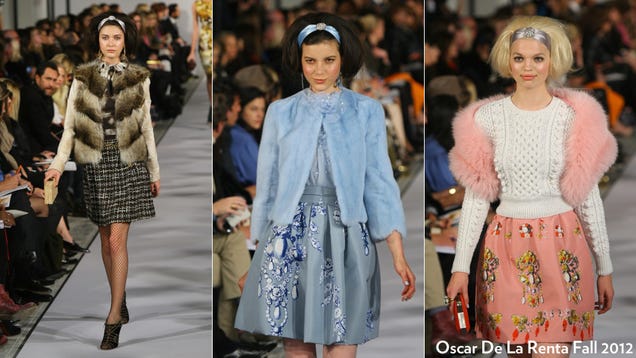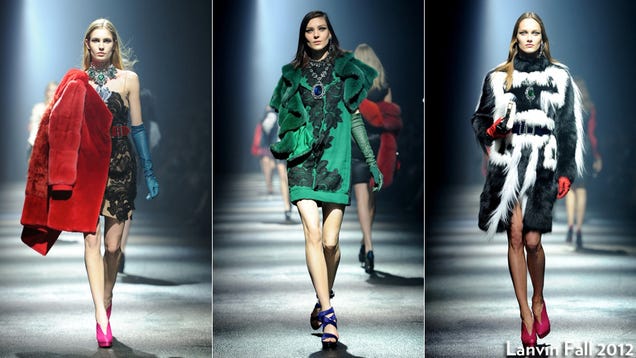Fur Is Back Big Time — Here’s Why
This development is surprising to anyone who remembers the highly publicized battles over fur and animal welfare of the 1980s and 1990s. Back then, shocking depictions of the cruelty inherent in fur production — often in the form of polemical and, critics said, misleading videos produced by pro-animal-rights fringe groups — were only starting to reach a wider audience. Protesters were omnipresent at fashion week and public pressure to avoid fur was high. Anna Wintour was served a skinned raccoon at the Four Seasons. It seemed like every week another of your favorite celebrities was stripping off for a PETA ad. By turn of the millennium, the moral issue of fur seemed settled, and fur itself seemed like a relic of a bygone age — something that your grandparents’ generation had misguidedly believed was okay, like golliwog dolls or smoking during pregnancy. The idea of wearing something so thoroughly politicized and icky as fur just seemed ugly. Popular culture kept up with the times: when Lily Esposito chided Mary Cherry for her mink coat on Popular, Mary Cherry looked like the spoiled, amoral wench that she was.

But during the 2000s, things changed. Designers who hadn’t previously shown fur on the runway began showing it; designers who had previously shown some, showed more. Designers who had publicly pledged to abjure fur, like Giorgio Armani, went back on their word — as did a good number of those overexposed PETA “faces.” (Naomi Campbell even went so far as to do an ad campaign for the furrier Dennis Basso.) Fur began to creep back into fashion magazine pages. 1990s grunge and minimalism gave way to 2000s bling and ostentation. And now, fur is back in a big way. This year’s fall runways? Among the designers who showed fur and/or shearling were Alexander McQueen, Dolce & Gabbana, Lanvin, Louis Vuitton, Michael Kors, Oscar de la Renta, Prada, Rebecca Minkoff, Salvatore Ferragamo, Tom Ford, Vivienne Westwood, and Yves Saint Laurent.

This reversal is not merely the result of a cultural trend meeting its inevitable backlash. It’s also a story of economics, and of the fur industry’s quiet battle to rebrand its product as sustainable, natural, and luxurious.
Fashion is still a very top-down business. A fur coat in a designer’s fall collection might retail for $10,000 and be ordered by a handful of stores; but that fur coat’s value in visibility for fur as a whole helps sell thousands of $60 rabbit-trimmed Michael Kors hats and $400 coyote-trimmed men’s jackets at Macy’s. To help make fur a trend that pops up in magazine editorials and online, fur suppliers often sponsor designers, giving them free product to incorporate into their seasonal collections and even sending them on junkets. In 2010, the New York Times reported that one Scandinavian supplier, Saga Furs, gave fur to Cushnie et Ochs, Thakoon, Brian Reyes, Wayne, Derek Lam, Proenza Schouler and Richard Chai. It also paid for three designers to go on a junket:
Last summer, for example, the designers Alexander Wang and Haider Ackermann, plus Alexa Adams and Flora Gill of Ohne Titel were flown to Copenhagen for weeklong visits to the design studios of Saga Furs, a marketing company that represents 3,000 fur breeders in Finland and Norway. Saga Furs regularly sponsors such design junkets.
Another fur supplier, the North American Fur Auctions, gave furs that year to Bibhu Mohapatra and Prabal Gurung. “We want to make sure fur is on the pages of magazines around the world,” said the NAFA’s director of marketing at the time. “The way to do that is to facilitate the use of fur by designers.”

Fur industry organizations sponsor design contests at top fashion schools, including Parsons and the Fashion Institute of Technology. (So does PETA, which enjoyed some institutional support at Parsons back when Tim Gunn was dean of its fashion school.) The prizes are often lavish, including free international travel and tens of thousands of dollars worth of product — perfect for a young designer who needs backing to launch a line. It’s no accident that fur is increasingly present on the runways: the fur industry has spent years patiently working to re-legitimize and de-stigmatize its product in the eyes of a new generation of fashion tastemakers, and fur’s current boom is the fruit of their labors. A 2007 ad campaign even called fur “the natural, responsible choice.” Alice Olivia designer Stacey Bendet, herself a vegan, wears fur and uses it in her collection. “It doesn’t make sense,” she once admitted. “Something about putting it inside me feels really barbaric. Something about wearing it just feels a little glamorous.”

Established designers like Zac Posen now see no downside to collaborating with fur brands — c.f. Posen’s collection for Pologeorgis. Even a series of minor scandals over fur labeling hasn’t served to set back the industry.
Five years ago, PETA founder Ingrid Newkirk said that only “old fogey designers like Karl Lagerfeld and so on” used fur, and that fashion’s new generation just wasn’t that into fur. Clearly, Newkirk was wrong.
In the past decade, fur has gone from being a kind of ethical third rail to just one point on the developing moral questionnaire of modern living. Maybe you care more about the environmental degradation, animal cruelty, and labor issues brought up by the leather tanning industry, or factory farms. Perhaps you think nothing of wearing vintage fur because to throw out a useful garment smacks of waste. Maybe you believe, like Silvia Fendi, that real fur is preferable to fake because, as she put it, “We did a collection of fake fur several years ago but found it is the most polluting thing for the environment.” Perhaps you feel a little like Kelis, who concluded a long MySpace rant against PETA by weighing concern over animal welfare to concern for the human beings who toil in sweatshops and in the fields. “Underpaid minorities picking your vegetables, now that’s fine for you right?” asked Kelis. “Don’t waste my time trying to save the dang chipmunk!”
Whatever the case, fur is back in a big way. And it seems to be here to stay for the foreseeable future.
kaufmanfurs.com
